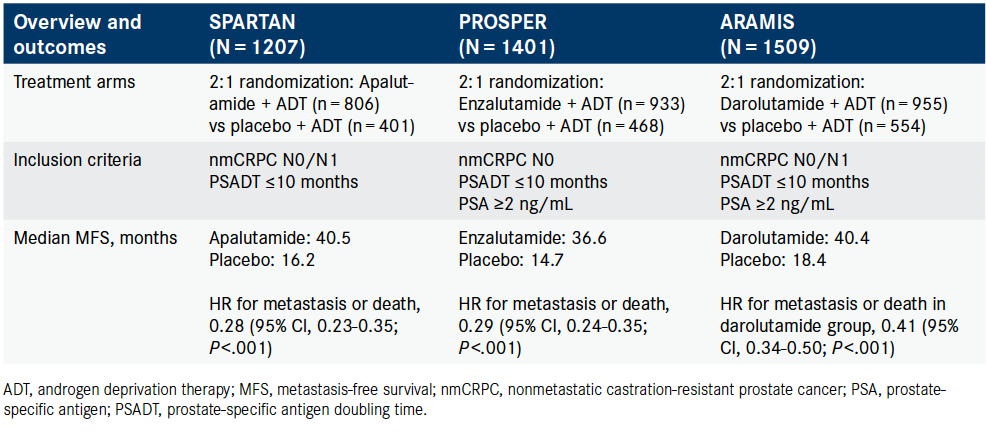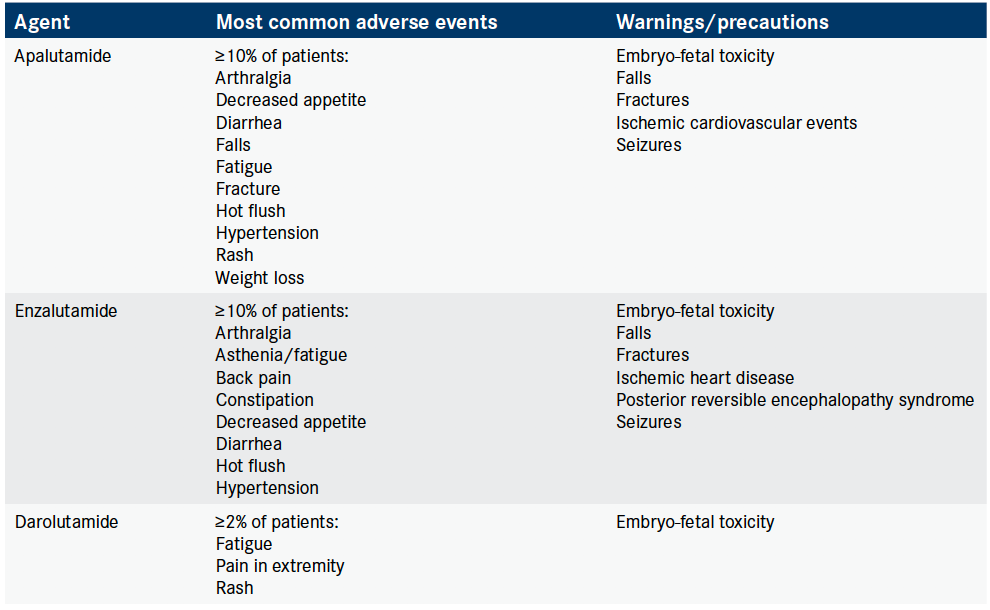Evaluating the Nonmetastatic CRPC Landscape: What Have We Learned?
A panel of experts provide their insights on how and when they are using novel imaging versus conventional imaging. They also discuss the data regarding the FDA-approved AR-targeted therapies, how they select between them, and their strategies for mitigating any adverse events.
Neal Shore, MD

Nonmetastatic castration-resistant prostate cancer (nmCRPC) is a heterogeneous disease with variable risk of metastasizing. Historically, it has been called M0 CRPC and was a disease entity with great unmet need and little level 1 evidence to guide diagnosis and treatment. However, novel imaging techniques are starting to redefine this disease state, and the FDA approval of 3 androgen receptor (AR)–targeted therapies over the past 3 years is enabling these patients to live free of metastasis longer, with the latest data also showing improved overall survival (OS), when these agents are combined with androgen deprivation therapy (ADT). Although these therapies are well tolerated by most patients, this is a largely asymptomatic group that will require long-term treatment, making it particularly important to avoid untoward treatment-related effects that can compromise their quality of life.
During an OncLive Peer Exchange®, a panel of experts in treating advanced prostate cancer provided their insights on how and when they are using novel imaging versus conventional imaging. They also discussed the data regarding the FDA-approved AR-targeted therapies, how they select between them, and their strategies for mitigating any adverse events (AEs). “It’s been a really exciting time in the world of prostate cancer, particularly advanced prostate cancer, with great breakthroughs,” moderator Neal Shore, MD, said when kicking off the session.
Identifying nmCRPC: PSA Level, Doubling Time, and Novel Imaging
In the 3 pivotal clinical trials that led to the approval of the 3 AR-targeted therapies, patients with nmCRPC were defined as those who experienced a biochemical recurrence (ie, consistently rising prostate-specific antigen [PSA] levels) after having undergone definitive local therapy, whether prostatectomy or radiation, yet had no evidence of metastatic disease on conventional imaging (ie, standard computed tomography [CT] of the abdomen and pelvis and a bone scan). Notably, 2 of the trials enabled patients with greater than 2 cm of measurable disease in their pelvic lymph nodes to enroll. Across the 3 trials, the patients’ PSA doubling time was at least 10 months.
“If [PSA doubling time] is greater than 12 months, we have some data to suggest in biochemical recurrent populations and in nmCRPC populations, that these patients are less likely to die from prostate cancer or develop metastatic disease. So, it really is that patient population with the shorter PSA doubling time, like included in the trials, that I think about treating now that we have data for prolongation of MFS [metastasis-free survival],” panelist Alicia K. Morgans, MD, MPH, said.
The panelists proceeded to discuss how they calculate PSA doubling time and when they pull the trigger to start treating patients. Morgans said she uses an online calculator by Memorial Sloan Kettering,1 whereas other physicians said they perform the calculation by hand. The panelists indicted there is no clear consensus on when to start treatment based on PSA level and doubling time. “There are some groups who don’t start on ADT until a patient’sPSA is 5 to 10 ng/mL and moving rapidly with a short doubling time, whereas others will start right away,” panelist Pedro C. Barata, MD, MSc, said.
Another challenge Barata noted is that the advent of novel imaging modalities, including fluciclovine (Axumin) and gallium-68 prostate-specific membrane antigen (PSMA) positron emission tomography (PET) scans, have revealed that many patients with nmCRPC actually have some metastatic disease that cannot be identified using conventional imaging. “If you look at the data in terms of sensitivity, you will know that if you’re going to use fluciclovine—which is FDA approved here in the United States—once you have a PSA greater than 2 ng/mL, your sensitivity or chance of finding metastatic disease is going to be higher, perhaps greater than 50%,” Barata said.
Fluciclovine F18 injection for PET imaging was approved by the FDA in May 2016 to assess prostate cancer status in men with biochemical recurrence.2 Gallium-68 PSMA is anticipated to be approved soon. “By the end of the summer [2020] we may, in the United States, have ubiquitous access to gallium-68 PSMA imaging. We’re behind the rest of the world, where it’s been around for a long period of time,” Shore said. Nevertheless, many of the panelists have had access to gallium-68 PSMA because of their research activities.
Panelist Nancy Ann Dawson, MD, has been regularly sending some of her patients to the National Institutes of Health for gallium-68 PSMA imaging. She is involved with the ARROW study (NCT03939689), which requires patients to meet certain PSMA-avidity criteria for inclusion.3 ARROW is investigating the anti-PSMA therapy I-131-1095, a small-molecule radiotherapeutic that selectively binds to the extracellular domain of PSMA, a protein that is highly expressed on prostate cancer cells.4 Dawson suggested these scans could also be important for patients for whom a prostatectomy is planned. “The data show all the occult disease that’s picked up on PSMA scanning would be pretty important to know,” she said.
As for the fluciclovine scans, Dawson said she does not use them as often as conventional imaging. “The patients I tend to use more of the Axumin [fluciclovine] scans are the patients I don’t find metastases in,” she said. If conventional imaging reveals metastatic disease, Dawson is not necessarily motivated to find more disease by then following up with a novel imaging modality. “The patient is already upset. They have been told they have metastatic disease and they have 3 or 5 lesions. I don’t need to tell them they really have 50 lesions,” she said. However, if conventional imaging does not show metastatic disease, she may be inclined to use novel imaging to help guide treatment. “If I don’t find anything and I perform an Axumin scan and find a small lymph node up in the patient’s supraclavicular area, my radiation oncologist might want to radiate that oligometastatic disease if the patient does not want to go on hormonal therapy…Mostly, I’m [using these scans to] look for disease that I didn’t already find because I’m planning to do something about it,” she said.
Shore encouraged clinicians to review the 2019 report from the Advanced Prostate Cancer Consensus Conference, which was published April 2020, in European Urology.5 During the conference, prostate cancer experts from around the world voted on 123 predefined questions regarding areas of controversy across the advanced prostate cancer spectrum, including imaging following biochemical recurrence. The votes strongly favored PSMA PET/CT over any other modalities, gaining 80% of the votes for patients with rising PSA after radiation and 87% of the votes for those with rising PSA after radical prostatectomy. In contrast, fluciclovine or choline PET/CT only received 7% of the vote in the postradiation setting and 4% of the vote in the postprostatectomy setting. “We’re heading into an interesting area, and different working groups are starting to really weigh in on this now and trying to come up with further consensus panels,” Shore said.
It became clear during the discussion that the days of M0 or nmCRPC as a disease entity may be numbered. “When we use conventional imaging, we often can’t see it, [but] some of these newer imaging tests pick up on some metastatic disease in almost all of these patients. This disease state is not only shrinking, but it may go away in the future,” panelist William Oh, MD, surmised.
Examining AR-Targeted Therapy for nmCRPC
The 3 AR-targeted therapies currently approved by the FDA to treat patients with nmCRPC include apalutamide (Erleada),approved February 2018 based on the SPARTAN trial (NCT01946204); enzalutamide (Xtandi), approved July 2018 based on the PROSPER trial (NCT020032924); and darolutamide (Nubeqa), approved July 2019 based on the ARAMIS trial (NCT02200614).6-8 These phase 3 studies were similarly designed and showed a similar MFS survival, which was the primary end point in all 3 trials.9-11
MFS is an unusual end point, and Oh said he was surprised the FDA accepted it, noting it is clinically meaningful. “We know when physical metastases on conventional imaging can be seen—as opposed to fluciclovine or a PSMA—those patients can develop symptomatic disease within a short period of time,” he explained.

Morgans emphasized that she makes her treatment decisions regarding nmCRPC based on conventional imaging findings because this is how the SPARTAN, PROSPER, and ARAMIS trials were designed. “Even if a patient has M1 disease by molecular imaging, as you mentioned, I still feel that patient can benefit from [these] drugs,” she said, noting they are approved across the prostate cancer spectrum, including nmCRPC, metastatic castration sensitive prostate cancer, and metastatic CRPC. “[Because] there’s benefit across the spectrum, I feel pretty comfortable with that decision,” she said (Table 19-11).
Table 1. Final Primary Outcomes of the SPARTAN, PROSPER, and ARAMIS Trials9-11

When selecting between apalutamide, enzalutamide, and darolutamide, Morgans said the first thing she considers is their AE profile (Table 2).12-14 “They all have their distinct adverse events,” she explained.
Table 2. Most Common Adverse Events and Warnings/Precautions12-14

“Fatigue and hypertension might be more common in enzalutamide; a rash and thyroid problems, as well as some fatigue, may be more common with apalutamide; and darolutamide may still cause a little fatigue. There may be falls across the board, but less so with darolutamide,” she said.
The panelists said other important considerations include patient comorbidities and drug-to-drug interactions, including with other prostate cancer treatments like ADT. “We know that when we put [some] patients on ADT, they complain about tiredness, how they can’t remember where they put their keys, and things that we may not appreciate might be interfering with their lives. There’s a small subset who are really affected cognitively…[and] you’re now adding drugs like enzalutamide, apalutamide, or darolutamide in asymptomatic patients and committing them to years of therapy,” Oh said. Subsequently, he said it is important for clinicians to pay close attention to the AEs their patients are experiencing while on these therapies.
Because patients may not be forthcoming about their AEs, the panelists recommended asking patients and/or their caregivers more detailed questions, such as where they got a bruise/injury, how they are feeling and getting around, and what their day looks like. Oh recounted the case of a patient who came in with a large bruise on his face a few months after starting enzalutamide. After asking the patient about his injury, he learned that the patient had tripped several times while on treatment but did not attribute this to ADT or enzalutamide. Subsequently, if the patient had not presented with the bruise and Oh had not questioned him about it, this AE likely would have been missed.
Another important strategy to identify AEs is to inform patients upfront that multiple drugs are available, so they know they have other options, recommended Dawson. “[Some patients] don’t want to tell me about AEs because they don’t think they have any other option. The say, ‘You put me on this to make me live longer, and I want to live longer. I guess I’ll just have to put up with this’…Once they realize they might have another option, that allows them to feel more comfortable telling me [there’s something wrong and] instead of this drug I’ve given them to save their life, there might be another one they can try instead,” she said.
In the setting of AEs, the panelists generally preferred switching agents instead of dose reductions or interruptions. “When I had fewer choices, the first thing I would do is stop the therapy and then rechallenge at a lower dose. Now, I [tend to] switch some patients from 1 agent to another because sometimes with dose reductions, they may still have some of those AEs,” Oh said.
Oh found darolutamide to be an especially interesting drug in respect to its AE profile because in clinical trials it was comparable with placebo. “If it’s because it doesn’t cross the blood–brain barrier, then that would be very interesting and intriguing for me as a clinician and for my patients,” he said. Darolutamide has a different chemical structure than apalutamide and enzalutamide, and studies in rodents suggest darolutamide does not penetrate the blood–brain barrier, unlike apalutamide and enzalutamide.15 In a rat study using radiolabeled darolutamide and enzalutamide, darolutamide had a 10-fold lower blood–brain barrier penetration than enzalutamide (approximately 0.074 vs 0.765), and it was significantly eliminated from almost all organs and tissues 8 hours after administration, whereas enzalutamide remained constant within the body.16 More studies are needed, but this finding may help explain why central nervous system–related events such as seizures have not been associated with darolutamide in clinical trials.
An OS Advantage
Although many patients with nmCRPC will ultimately progress, OS data for darolutamide, enzalutamide, and apalutamide have now matured and show a significant survival advantage with these therapies plus ADT versus placebo plus ADT. Final OS analyses for all 3 agents were presented at the 2020 American Society of Clinical Oncology Virtual Scientific Program. Darolutamide reduced the risk of death by 31% compared with placebo (HR, 0.69; 95% CI, 0.53-0.88; P = .003).17 The OS rates at 3 years were 83% and 77%, respectively. It also delayed the time to pain progression, time to first initiation of cytotoxic chemotherapy, and time to first symptomatic skeletal event.
Enzalutamide showed similar results, reducing the risk of death by 27% compared with placebo (HR, 0.73; 95% CI, 0.61-0.89; P = .001), with a median OS of 67.0 months in the enzalutamide arm and 56.3 months in the placebo arm.18 Fewer men in the enzalutamide arm went on to receive antineoplastic therapies (33% [n = 930] vs 65% [n = 465] in the placebo arm). The survival advantage was slightly lower with apalutamide, which reduced the risk of death by 22% compared with placebo (HR, 0.78; 95% CI, 0.64-0.96; P = .0161), with a median OS of 73.9 months compared with 59.9 months with placebo.19 Like the other AR-targeted therapies, apalutamide reduced the time to cytotoxic chemotherapy.
“It’s quite powerful because drugs like enzalutamide and abiraterone have been around for many years now in the metastatic CRPC setting. Shifting them to earlier use and still having them associated with an OS benefit is a very powerful statement that earlier use of these drugs is really meaningful in terms of OS,” Oh said.
References
1. Prostate cancer nomograms: PSA doubling time. Memorial Sloan Kettering Cancer Center. Accessed June 1, 2020. bit.ly/37g9eAp
2. FDA approves new diagnostic imaging agent to detect recurrent prostate cancer. US Food & Drug Administration. Released May 27, 2016. Accessed May 15, 2020. bit.ly/2yWoGVT
3. Study of I-131-1095 radiotherapy in combination with enzalutamide in patients with metastatic castration-resistant prostate cancer who are chemotherapy naive and have progressed on abiraterone (ARROW). US National Library of Medicine. ClinicalTrials.gov. Updated May 7, 2020. Accessed May 15, 2020. https://www.clinicaltrials.gov/ct2/show/NCT03939689
4. Progenics advances 1095, PSMA-targeted therapeutic candidate for the treatment of metastatic prostate cancer, into phase 2 clinical development following discussions with the FDA. News release. Progenics Pharmaceuticals; October 11, 2018. Accessed May 15, 2020. bit.ly/36exnac
5. Gillessen S, Attard G, Beer TM, et al. Management of patients with advanced prostate cancer: report of the Advanced Prostate Cancer Consensus Conference 2019. Eur Urol. 2020;77(4):508-547. doi:10.1016/j.eururo.2020.01.012
6. FDA approves apalutamide for non-metastatic castration-resistant prostate cancer. US Food & Drug Administration. February 2018. Accessed May 17, 2020. bit.ly/2ACJIZZ
7. FDA approves enzalutamide for castration-resistant prostate cancer. US Food & Drug Administration. July 13, 2020. Accessed May 17, 2020. bit.ly/3bGKSk2
8. FDA approves darolutamide for non-metastatic castration-resistant prostate cancer. US Food & Drug Administration. July 30, 2019. Accessed May 16, 2020. bit.ly/2AC355s
9. Smith MR, Saad F, Chowdhury S, et al; SPARTAN Investigators. Apalutamide treatment and metastasis-free survival in prostate cancer. N Engl J Med. 2018;378(15):1408-1418. doi:10.1056/NEJMoa1715546
10. Hussain M, Fizazi K, Saad F, et al. Enzalutamide in men with nonmetastatic, castration-resistant prostate cancer. N Engl J Med. 2018;378(26):2465-2474. doi:10.1056/NEJMoa1800536
11. Fizazi K, Shore N, Tammela TL, et al; ARAMIS Investigators. Darolutamide in nonmetastatic, castration-resistant prostate cancer. N Engl J Med. 2019;380(13):1235-1246. doi:10.1056/NEJMoa1815671
12. Erleada. Prescribing information. Janssen Products LP; 2019. Accessed June 1, 2020. bit.ly/37dxQd0
13. Xtandi. Prescribing information. Astellas Pharma US Inc; 2019. Accessed June 1, 2020. bit.ly/2ziPlfF
14. Nubeqa. Prescribing information. Bayer HealthCare Pharmaceuticals Inc; 2019. Accessed June 1, 2020. bit.ly/3cTxOZi
15. Darolutamide delays the spread of some prostate cancers. National Cancer Institute. Published March 15, 2019. Accessed May 17, 2020. bit.ly/2zPeDSA
16. Zurth C, Sandmann S, Trummel D, et al. Blood-brain barrier penetration of [14C]darolutamide compared with [14C]enzalutamide in rats using whole body autoradiography. J Clin Oncol. 2018;36(suppl 6; abstr 345). doi:10.1200/JCO.2018.36.6_suppl.345
17. Fizazi K, Shore ND, Tammela T, et al. Overall survival (OS) results of phase III ARAMIS study of darolutamide (DARO) added to androgen deprivation therapy (ADT) for nonmetastatic castration-resistant prostate cancer (nmCRPC). J Clin Oncol. 2020;38(suppl15; abstr 5514). doi:10.1200/JCO.2020.38.15_suppl.5514
18. Sternberg CN, Fizazi K, Saad F, et al. Final overall survival (OS) from PROSPER: A phase III, randomized, double-blind, placebo (PBO)-controlled study of enzalutamide (ENZA) in men with nonmetastatic castration-resistant prostate cancer (nmCRPC). J Clin Oncol. 2020;38(suppl 15; abstr 5515). doi:10.1200/JCO.2020.38.15_suppl.5515
19. Small EJ, Saad F, Chowdhury S, et al. Final survival results from SPARTAN, a phase III study of apalutamide (APA) versus placebo (PBO) in patients (pts) with nonmetastatic castration-resistant prostate cancer (nmCRPC). J Clin Oncol. 2020;38(suppl 15; abstr 5516). doi:10.1200/JCO.2020.38.15_suppl.5516
20. Bouchelouche K, Choyke PL, Capala J. Prostate specific membrane antigen- a target for imaging and therapy with radionuclides. Discov Med. 2010;9(44):55-61
21. National Comprehensive Cancer Network. Clinical Practice Guidelines in Oncology. Prostate cancer (version 2.2020). Accessed January 20, 2020. bit.ly/2AiD0IO




